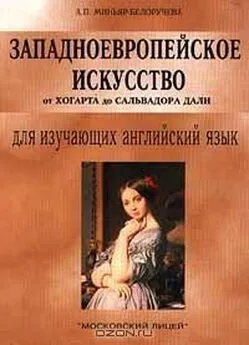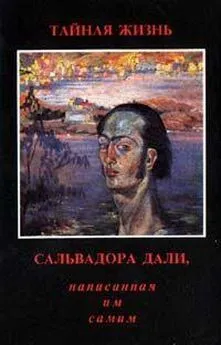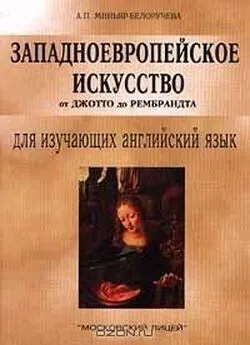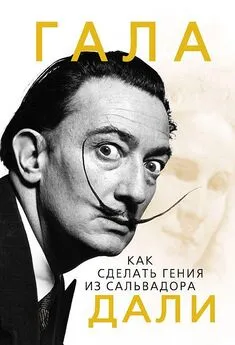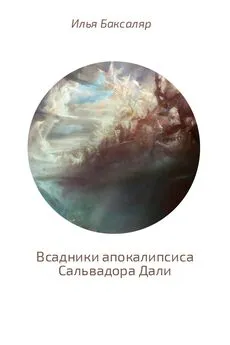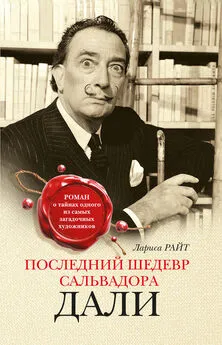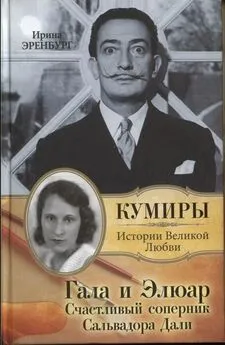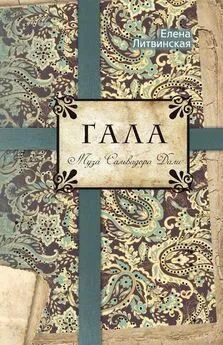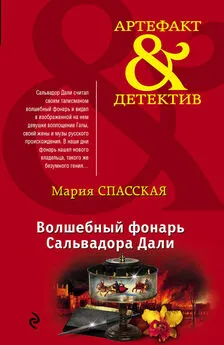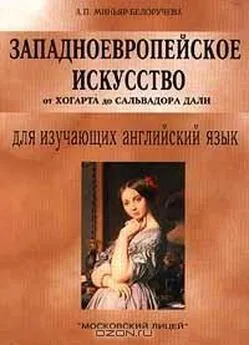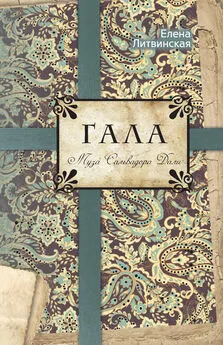Алла Миньяр-Белоручева - Западноевропейское искусство от Хогарта до Сальвадора Дали
- Название:Западноевропейское искусство от Хогарта до Сальвадора Дали
- Автор:
- Жанр:
- Издательство:«Московский Лицей»
- Год:1999
- Город:Москва
- ISBN:5-7611-0182-3
- Рейтинг:
- Избранное:Добавить в избранное
-
Отзывы:
-
Ваша оценка:
Алла Миньяр-Белоручева - Западноевропейское искусство от Хогарта до Сальвадора Дали краткое содержание
Тексты настоящего пособия охватывают почти три века истории западноевропейского искусства от Хогарта до Сальвадора Дали. Это позволяет обучаемым наряду с усвоением обширного лексического материала, приобрести культурологические знания, поскольку тексты содержат информацию о жизни и творчестве крупнейших западно-европейских художников XVIII – XX вв. Система упражнений направлена на усвоение лексического материала и развитие навыков устной речи.
Данная книга является второй частью цикла учебных пособий «Западноевропейское искусство (для изучающих английский язык)». В первую книгу вошли тексты, охватывающие пять веков западноевропейской живописи oт Джотто до Рембрандта. Данное пособие предназначено для студентов-искусствоведов, учащихся классических гимназий, лицеистов и всех изучающих английский язык и интересующихся западноевропейским искусством.
Западноевропейское искусство от Хогарта до Сальвадора Дали - читать онлайн бесплатно полную версию (весь текст целиком)
Интервал:
Закладка:
Constable said that Gainsborough's landscape moved him to tears, and contemplating the freedom and beauty of the painting of the cart and a boy gathering brushwood, not to speak of the glow of light seeming to come from within the tree in the centre, one can understand why.
Make sure you know how to pronounce the following words:
Thomas Gainsborough; Van Dyck; embroidered; abandonment; rhapsodic; organdy; Howe; aristocracy; Hobbema, Watteau
Mary Countess Howe – «Графиня Мери Хью»
Market Cart – «Телега, едущая на рынок»
I. Read the text. Make sure you understand it. Mark the following statements true or false.
1. Until 1774 Gainsborough lived and worked in Italy.
2. Gainsborough's figures are abundant.
3. Gainsborough's portraits were influenced by Titian.
4. Gainsborough's brushwork was free and bold.
5. Gainsborough's landscapes were classical.
6. Gainsborough was abandoned to nature.
II. How well have you read? Can you answer the following questions?
1. What makes Gainsborough an outstanding painter?
2. Whose influence is felt in Gainsborough's portraits? What did Gainsborough achieve in his full-length portraits?
3. Where is the figure in Mary Countess Howe posed?
4. What do Gainsborough's landscapes exhale? What did Gainsborough prefer to paint in later life?
5. What does the Market Cart show?
6. What was said about Gainsborough's landscape?
III. i. Give Russian equivalents of the following phrases:
the most influential English painter; the elegant attenuation; a full-length portrait; to pose in front of a landscape background; the embroidered organdy of the overdress; the exquisite play of colour; to prefer landscapes to portraits; to paint landscapes in a studio; the grand manner; to move to tears; the painting of the cart; the shimmer of light; soft strokes; to gather brushwood.
ii. Give English equivalents of the following phrases:
трогать до слез; наиболее авторитетный художник; позировать на фоне пейзажа; предпочитать пейзажи портретам; хрупкость и изящество несколько удлиненных женских фигур; органди; портрет во весь рост; мягкие блики; писать пейзажи в студии; величественная манера; совершенная игра цвета; собирать хворост; изображение повозки; мягкие мазки.
iii. Make up sentences ofyour own with the given phrases.
iv. Arrange the following in the pairs of synonyms:
a) influential; occasional; exquisitely; environment; artificial;
b) unnatural; surroundings; infrequent; perfectly; important.
IV. Translate the text into English.
На формирование Томаса Гейнсборо – великого английского портретиста XVIII века, значительное влияние оказали работы Ван Дейка.
Пейзаж в портретах Гейнсборо имеет большое значение. В зрелом возрасте, когда Гейнсборо переселился в Лондон, он начал писать портреты во весь рост на фоне пейзажа. Модели Гейнсборо поэтичны. Художник придает особую хрупкость и изящество несколько удлиненным женским фигурам. Светлая колористическая гамма становится отличительной чертой его живописи. В портретах Гейнсборо отсутствуют аллегории. Гейнсборо прошел творческую эволюцию от детальной манеры, близкой «малым голландцам» к живописи широкой и свободной.
V. Summarize the text.
VI. Topics for discussion.
1. Gainsborough's portraits.
2. Gainsborough's style.
Unit III Reynolds (1723-1792)
Sir Joshua Reynolds was in his own day a commanding figure, whose authority outlived him and who eventually became a target for Romantic attacks. In Reynolds's day society portraiture had become a monotonous repetition of the same theme. According to the formula, the sitter was to be posed centrally, with the background (curtain, pillar, chair, perhaps a hint of landscape) disposed like a back-drop behind; normally the head was done by the master, the body by a pupil or «drapery assistant», who might serve several painters. Pose and expression tended to be regulated to a standard of polite and inexpressive elegance; the portrait told little about their subjects other than that they were that sort of people who had their portraits painted. They were effigies; life departed.
It was Reynolds who insisted in his practice that a portrait could and should be also full, complex work of art on many levels; he conceived his portraits in terms of history-painting. Each fresh sitter was not just a physical fact to be recorded, but rather a story to be told. His people are no longer static, but caught between one moment and the next. Reynolds was indeed a consummate producer of character, and his production methods reward investigation. For them he called upon the full repertoire of the Old Masters.
Reynolds did the Grand Tour and remained in Rome spellbound by the grandeur of Michelangelo, Raphael, Tintoretto and Titian. He acquired a respectable knowledge of European painting of the preceding two centuries, and gave at the Royal Academy of Arts -which he helped to found in 1768 – the famous Discourses , which in published form, remain a formidable body of Classical doctrine. In his Discourses Reynolds outlined the essence of grandeur in art and suggested the means of achieving it through rigorous academic training and study of the Old Masters. From 1769 nearly all Reynolds's paintings appeared in the Academy. Reynolds's success as a portraitist was so great that he was employing studio assistants to lay out the canvases for him and to do much of the mechanical work. The artist's technique was sound, and many of his works of art suffered as a result. After his visit to the Netherlands where he studied the works of Rubens Reynolds's picture surface became far richer. This is particularly true of his portrait the Duchess of Devonshire and Her Daughter . Reynolds's state portraits of the King and Queen were never successful, and he seldom painted for them. There is inevitably something artificial about the grandiloquence of the Classical or Renaissance poses in which he painted solid English men and women of his own day, investing them with qualities borrowed from a noble past. Nonetheless, we owe our impression of English aristocracy in the eighteenth century to his majestic portraits, with their contrived backgrounds of Classical architecture and landscape. Lady Sara Bun-bury Sacrificing to the Graces , of 1783, speaks eloquently for itself. Among Reynolds's best works are those in which he departs from the tradition of ceremonial portraiture and abandons himself to inspiration, as in The Portrait of Nelly O'Brien , which is aglow with light, warmth and feeling.
Make sure you know how to pronounce the following words:
Joshua Reynolds; Sarah; grandeur; inevitably; majestic; grandiloquence; discourses
I. Read the text. Mark the following statements true or false.
1. Reynolds never travelled outside Britain.
2. The Royal Academy of Arts was founded in 1758.
3. Reynolds hired assistants to lay out the canvases for him.
4. Reynolds created state portraits of the King and Queen.
II. How well have you read? Answer the following questions:
1. Who became a target for Romantic attacks? Why?
2. What fascinated Reynolds during the Grand Tour?
3. What remains a formidable body of Classical doctrine?
4. How great was the success of Reynolds as a portraitist?
5. Whom did Reynolds portray? How did he depict them?
III. i. Give Russian equivalents of the following phrases:
a commanding figure; to speak eloquently; the preceding two centuries; to become a target for smb; the grandiloquence of the poses; the Royal Academy of Arts; to lay out the canvases.
ii. Give English equivalents of the following phrases:
Королевская Академия искусств; готовить холст для к-л; торжественные позы; великолепные портреты; авторитетная фигура; два предшествующих века; стать мишенью для к-л.
iii. Make up sentences of your own with the given phrases
IV. Here are names of the English painters and the titles of their works of art. Match them up. Describe the paintings.
1. Reynolds
2. Hogarth
3. Gainsborough
a. A Rake's Progress
b. Lady Sarah Bunbury
c. Market Cart
d. Mary Countess Howe
V. Translate the text into English.
Первым президентом Королевской Академии искусства, открытой в 1768, был Джошуа Рейнольдсс. Теоретически он выступал как сторонник классицизма, однако практически выходил за рамки этого направления. В молодости Рейнольдсс посетил Италию, в старости – Голландию и Фландрию. Он восхищался колоритом Тициана и Рубенса и многому научился как у них, так и у Рембрандта. После переезда в Лондон в 1753 г. Рейнольдсс стал самым знаменитым портретистом Британии. Иногда он писал до 150 портретов в год. В форме парадного портрета Рейнольдсс сумел выразить веру в человека. С появлением Рейнольдсса английская живопись получила всеобщее признание.
VI. Summarize the text.
VII. Topics for discussion.
1. Reynolds's portraits.
2. Reynolds's Enlightenment activity.
Unit IV Ingres (1780-1867)
Jean-Auguste-Dominique Ingres remained faithful to Neo-classic ideals to the end of his life, he formed the centre of the conservative group that utilised the Principles of Neo-classicism, forged in the Revolution (1789-1799) as a weapon for reaction. Ingres was an infant prodigy, attending art school at eleven, and a capable performer on the violin. He entered the studio of David at seventeen, but as long as he lived he never accepted the cubic mass of David's mature style preferring curving forms flowing like violin melody. Winner of the Grand Prix de Rome , he remained in that city from 1806 until 1820, and returned there from 1835 to 1841, absorbing not only ancient but also Renaissance art, especially that of Raphael. Ingres stayed four years in Florence (1820-24) where he was one of the first to appreciate the Florentine Mannerists. The first pictures he exhibited at the Salon were almost uniformly ridiculed, accused of being everything from Gothic to Chinese, and his special non-political Neo-classicism was worked out in isolation.
Читать дальшеИнтервал:
Закладка:
